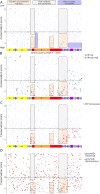Genotype-structure-phenotype relationships diverge in paralogs ATP1A1, ATP1A2, and ATP1A3
- PMID: 30842972
- PMCID: PMC6384024
- DOI: 10.1212/NXG.0000000000000303
Genotype-structure-phenotype relationships diverge in paralogs ATP1A1, ATP1A2, and ATP1A3
Abstract
Objective: We tested the assumption that closely related genes should have similar pathogenic variants by analyzing >200 pathogenic variants in a gene family with high neurologic impact and high sequence identity, the Na,K-ATPases ATP1A1, ATP1A2, and ATP1A3.
Methods: Data sets of disease-associated variants were compared. Their equivalent positions in protein crystal structures were used for insights into pathogenicity and correlated with the phenotype and conservation of homology.
Results: Relatively few mutations affected the corresponding amino acids in 2 genes. In the membrane domain of ATP1A3 (primarily expressed in neurons), variants producing milder neurologic phenotypes had different structural positions than variants producing severe phenotypes. In ATP1A2 (primarily expressed in astrocytes), membrane domain variants characteristic of severe phenotypes in ATP1A3 were absent from patient data. The known variants in ATP1A1 fell into 2 distinct groups. Sequence conservation was an imperfect indicator: it varied among structural domains, and some variants with demonstrated pathogenicity were in low conservation sites.
Conclusions: Pathogenic variants varied between genes despite high sequence identity, and there is a genotype-structure-phenotype relationship in ATP1A3 that correlates with neurologic outcomes. The absence of "severe" pathogenic variants in ATP1A2 patients predicts that they will manifest either in a different tissue or by death in utero and that new ATP1A1 variants will produce additional phenotypes. It is important that some variants in poorly conserved amino acids are nonetheless pathogenic and could be incorrectly predicted to be benign.
Figures






Similar articles
-
Molecular cloning and characterization of porcine Na⁺/K⁺-ATPase isoforms α1, α2, α3 and the ATP1A3 promoter.PLoS One. 2013 Nov 13;8(11):e79127. doi: 10.1371/journal.pone.0079127. eCollection 2013. PLoS One. 2013. PMID: 24236096 Free PMC article.
-
ATP1A2- and ATP1A3-associated early profound epileptic encephalopathy and polymicrogyria.Brain. 2021 Jun 22;144(5):1435-1450. doi: 10.1093/brain/awab052. Brain. 2021. PMID: 33880529
-
De Novo ATP1A1 Variants in an Early-Onset Complex Neurodevelopmental Syndrome.Neurology. 2022 Mar 15;98(11):440-445. doi: 10.1212/WNL.0000000000013276. Epub 2022 Feb 2. Neurology. 2022. PMID: 35110381 Free PMC article.
-
The expanding spectrum of neurological phenotypes in children with ATP1A3 mutations, Alternating Hemiplegia of Childhood, Rapid-onset Dystonia-Parkinsonism, CAPOS and beyond.Pediatr Neurol. 2015 Jan;52(1):56-64. doi: 10.1016/j.pediatrneurol.2014.09.015. Epub 2014 Oct 13. Pediatr Neurol. 2015. PMID: 25447930 Free PMC article. Review.
-
Variants of ATP1A3 in residue 756 cause a separate phenotype of relapsing encephalopathy with cerebellar ataxia (RECA)-Report of two cases and literature review.Mol Genet Genomic Med. 2021 Sep;9(9):e1772. doi: 10.1002/mgg3.1772. Epub 2021 Aug 2. Mol Genet Genomic Med. 2021. PMID: 34342181 Free PMC article. Review.
Cited by
-
Rapid-Onset Dystonia-Parkinsonism Phenotype Consistency for a Novel Variant of ATP1A3 in Patients Across 3 Global Populations.Neurol Genet. 2021 Mar 15;7(2):e562. doi: 10.1212/NXG.0000000000000562. eCollection 2021 Apr. Neurol Genet. 2021. PMID: 33977143 Free PMC article. No abstract available.
-
Impact of fermented bamboo powder on the morphology and physiology of the gastrointestinal tract in yellow-feather broiler chickens.Poult Sci. 2025 Feb;104(2):104793. doi: 10.1016/j.psj.2025.104793. Epub 2025 Jan 14. Poult Sci. 2025. PMID: 39813869 Free PMC article.
-
ATP1A1 de novo Mutation-Related Disorders: Clinical and Genetic Features.Front Pediatr. 2021 Apr 21;9:657256. doi: 10.3389/fped.2021.657256. eCollection 2021. Front Pediatr. 2021. PMID: 33968856 Free PMC article.
-
ATP1A3-Related Disorders: An Ever-Expanding Clinical Spectrum.Front Neurol. 2021 Apr 1;12:637890. doi: 10.3389/fneur.2021.637890. eCollection 2021. Front Neurol. 2021. PMID: 33868146 Free PMC article. Review.
-
Downregulation of ATP1A1 Expression by Panax notoginseng (Burk.) F.H. Chen Saponins: A Potential Mechanism of Antitumor Effects in HepG2 Cells and In Vivo.Front Pharmacol. 2021 Oct 7;12:720368. doi: 10.3389/fphar.2021.720368. eCollection 2021. Front Pharmacol. 2021. PMID: 34690763 Free PMC article.
References
-
- Azizan EA, Brown MJ. Novel genetic determinants of adrenal aldosterone regulation. Curr Opin Endocrinol Diabetes Obes 2016;23:209–217. - PubMed
-
- Barcroft LC, Moseley AE, Lingrel JB, Watson AJ. Deletion of the Na/K-ATPase α1-subunit gene (Atp1a1) does not prevent cavitation of the preimplantation mouse embryo. Mech Dev 2004;121:417–426. - PubMed
Publication types
Grants and funding
LinkOut - more resources
Full Text Sources
